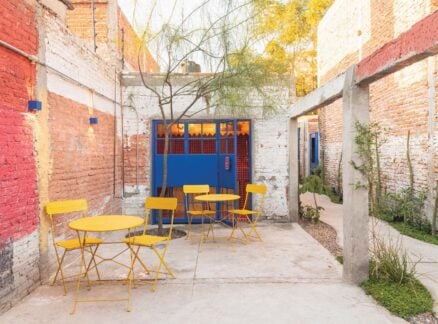
July 16, 2014
Made in the Shade: Landscaping in the Shadow of the High Line
The Green Team negotiates a shadowy undercroft of the High Line.
On multiple occasions, the Mathews Nielsen Green Team has addressed the challenges inherent in urban landscape architecture, from working around subgrade constraints, maximizing vertical space, and enhancing or even restoring the historic character of a site. Recently, the firm was challenged to design a courtyard in a tight Manhattan site between two buildings that surround three sides of a space bisected by a dominant overhead structure—the High Line.
The High Line proved to be the main site challenge, as it occupies much of the visual landscape and creates areas of permanent shade—limiting the plant palette and the ability to establish a lush, viable landscape. The presence of this structure, however, afforded our firm the opportunity to complement this notable urban landscape through a thoughtful extension of its strong design vocabulary to the at-grade green space below it by selecting richly textured plantings that dominate the space and compliment the adjacent architecture.

The site planting plan indicates the location of the High Line structure in grey and adjacent buildings in cream.
A new residential development designed by Robert A. M. Stern Architects, the Abington House, is an L-shaped building that shields the courtyard from the Lincoln Tunnel traffic on 10th Avenue. Its entry courtyard is situated next to an adjacent six-story building, open only to West 29th Street to the south. The High Line bisects the western half of this site, where the ground plane is punctuated by nine support columns that interrupt planting beds, driveways, and pedestrian walkways. These intrusions cast a fair amount of shade, which led to the selection of a plant palette comprised mainly of understory plant materials, similar to those seen carpeting woodland areas. This concept was beneficial in that the plant materials are rich in texture, scale, and color. These selections allowed Mathews Nielsen to create a lush environment that was welcoming at the pedestrian scale, standing in contrast to the surrounding structures.


Picea omorika (left) and Metasequoia glyptostroboides (right) each have conical mature forms.
Courtesy (left) Flickr users 5u5 and (right) F.D. Richards
Trees that take on an upright, conical shape when mature flank the overhead High Line structure. These include Serbian Spruce (Picea omorika) and Dawn Redwood (Metasequoia glyptostroboides). No trees could be located in the area directly below, so, to establish a verdant understory landscape, some semblance of a tree canopy was required to provide filtered shade in the open areas of the courtyard that would sustain and protect the shade plantings. Both of these elements act to slightly camouflage the structure while also complementing it through enhancement of the vertical, linear form of the columns, drawing one’s eye up to the surrounding architectural features. The mature trees are visible to passersby on the High Line and evoke a feeling of being in the upper reaches of woodland.

Heritage river birch and eastern redbuds provide dappled shade in the open courtyard area adjacent to the High Line.
While trees are used in the open-air portions of the courtyard for height and scale, a series of berms were created to add interest and topographic change throughout the landscape. This provides for undulating planting beds under the High Line in which flowering shade perennials sit atop the berms, with a fern mix planted in the low-lying area between them that mimics a wet woodland floor of dense shade plantings. The area is also irrigated to ensure the long-term survivability of the plant material. The “river of ferns” extends out from under the High Line and continues along the planting beds at the street frontage, again at the low point between berms, under the cover of Heritage River Birch (Betula nigra ‘Cully’) and understory Eastern Redbuds (Cercis canadensis). The berms are interplanted with grasses and perennials to add density to the beds, and an evergreen shrub border along the streetscape prevents access to the planted area.

The view to the High Line from the courtyard
What was originally perceived as a design challenge resulted in a multi-faceted landscape that juxtaposes the urban with the woodland and establishes a viable connection between the greater tiered landscapes. The design of the courtyard called for a very integrated approach among the site architecture, structure, and landscape to achieve a concept that embraces the presence of the High Line rather than trying to disguise it. The results are appreciated and experienced from both the street and structure levels, benefitting residents and High Line visitors alike.
Terrie Brightman, RLA, ASLA is a practicing landscape architect at Mathews Nielsen Landscape Architects in New York City with ten years of professional experience. Since receiving her BLA from the Pennsylvania State University, she has worked on riverfronts in Pittsburgh, private residences in California and Florida, a sustainable community in Turkey, and multiple public parks, plazas, and waterfronts throughout New York City.
This is one in a series of Metropolis blog posts written by members of Mathews Nielsen Landscape Architects’ Green Team that focus on research as the groundswell of effective landscape design and implementation. Addressing the design challenges the Green Team encounters and how it resolves them, the series shares the team’s research in response to project constraints and questions that emerge, revealing their solutions. Along the way, the team also shares its knowledge about plants, geography, stormwater, sustainability, materials, and more.





